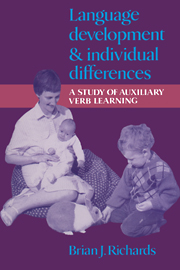Book contents
- Frontmatter
- Contents
- List of figures
- List of tables
- Preface
- Symbols used in transcription
- Pronunciation table
- PART I INTRODUCTORY SECTIONS
- Introduction
- 1 The auxiliary and the young language learner
- 2 Rate of auxiliary verb learning in thirty-three children
- PART II INDIVIDUAL DIFFERENCES AND AUXILIARY VERB LEARNING IN SEVEN CHILDREN
- PART III ENVIRONMENTAL INFLUENCES AND INDIVIDUAL DIFFERENCES IN AUXILIARY VERB LEARNING
- Notes
- References
- Index
1 - The auxiliary and the young language learner
from PART I - INTRODUCTORY SECTIONS
Published online by Cambridge University Press: 19 September 2009
- Frontmatter
- Contents
- List of figures
- List of tables
- Preface
- Symbols used in transcription
- Pronunciation table
- PART I INTRODUCTORY SECTIONS
- Introduction
- 1 The auxiliary and the young language learner
- 2 Rate of auxiliary verb learning in thirty-three children
- PART II INDIVIDUAL DIFFERENCES AND AUXILIARY VERB LEARNING IN SEVEN CHILDREN
- PART III ENVIRONMENTAL INFLUENCES AND INDIVIDUAL DIFFERENCES IN AUXILIARY VERB LEARNING
- Notes
- References
- Index
Summary
The importance of the auxiliary in the child's linguistic development
Auxiliary verbs are an essential component of most well-formed interrogatives, negation, ellipsis, positive emphasis, and the negative imperative. They convey temporal and aspectual meanings and, in the case of the modal verbs, meanings of possibility, ability, permission, volition, obligation and necessity. The modals also form the basis of hypothetical reference and, through variation on dimensions such as type of modality and tense, convey requests of differing degrees of politeness (Perkins, 1983a).
In the sequence of child language learning, analysis of emergence data (Wells, 1985) shows the importance of auxiliaries and the meanings they express in successive levels of development. Elaboration of the verb phrase is particularly dependent on the inclusion, co-occurrence and manipulation of the auxiliary element (see Wells, 1985, p. 269). It is also evident that children in the early stages of language learning are able to realise certain of the meanings and functions associated with the auxiliary by other means. Yes/No questions (Y/Ns) marked by intonation, and continuous and perfect aspect, for example, generally appear before the co-occurrence of the appropriate auxiliary and a main verb. Despite the possibility of alternative strategies to express auxiliary meanings, however, an increasing mastery of the syntax, semantics and pragmatics of auxiliary usage is an inextricable part of language development from an early stage.
Auxiliary verb learning
Studies of the auxiliary verb in young children
Studies which concentrate exclusively on the full range of auxiliary verbs or even a significant subset are relatively few in number.
Information
- Type
- Chapter
- Information
- Language Development and Individual DifferencesA Study of Auxiliary Verb Learning, pp. 5 - 16Publisher: Cambridge University PressPrint publication year: 1990
